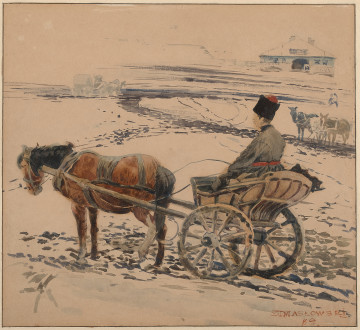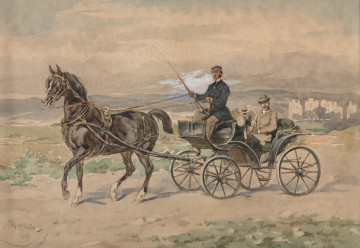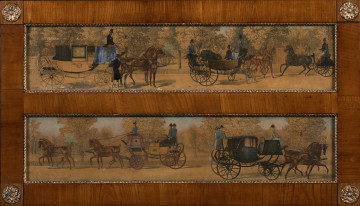
Peasant cartload
19th (?) century
Castle Museum in Łańcut
Part of the collection: Painting and drawing
Ruins of the Baths of Caracalla A painting from the collection of the Lubomirski family, former owners of the Łańcut Castle, behind glass, presents the ruins of the Baths of Caracalla in Rome. The light is falling from the left side of the painting, its source is the sun, not shown in the painting. Among ruins, there are small figures: a reaper and some men raking up hay as well as three men (one holding a cane) in the background of the painting. In the centre of the painting, there are ruins of the tepidarium overgrown with green vine. In the background, on the left hand side, there are the bath buildings and trees. The artwork was created by two artists, G. Volpato and L. Ducros. The Baths of Caracalla are the best preserved Roman baths, they are located to the south-west of Via Appia. Their construction started around 206 during the reign of Septimus Severus and they were commissioned in 216-217 during the reign of Caracalla, thence their name. The entire complex occupied approx. 12 hectares; there were cloakrooms, a palaestra (for gymnastic exercises), rooms for massage and leisure, a library, as well as saunas and a swimming pool with hot water. The interior of the building was decorated with numerous niches and recesses. The walls and the floors were covered with paintings and mosaics. The tepidarium is a leisure room with a heated floor ˗ the heat radiated from the walls and the floor. The frigidarium is a pool with cold water; one cooled there after bathing in the pool with hot water. Giovanni Volpato, one of the authors of the picture, was an engraver (born in Bassano del Grappa, died in Rome). He took the first lessons from his mother the embroiderer, and later studied from Giovanni Antonio Remondini. In 1762, he left for Venice, where he worked as an engraver for the Duke of Parma. In 1771, he moved to Rome and set up an engraving school there; Volpato gained recognition thanks to the series of engraved plaques from the Raphael Rooms in the Vatican Loggia. He also engraved a series of landscapes and Roman vedute. He took part in the excavations in the area of Ostia (1779). Together with an antiquarian, Volpato sold the sculptures excavated there to the King of Sweden, Gustav III, the Vatican Museum and a British collector. In 1792, together with Louis Ducros, he published a series of prints of the interior of the new Museo Pio Clementino. In 1785, he set u a porcelain factory, where replicas of Greek and Roman originals were produced, thus satiating the demand for ancient art in the period of neo-Classicism. He died in Rome in 1803. Abraham Louise Rodolphe Ducros (born in 1748 in Yverdorn in Switzerland and deceased in 1810) was a self-taught painter. He painted primarily watercolours (there are only few oil paintings). In 1776, he left for Rome and spent 30 years there. When in Italy, he saw the graphic prints of Piranesi and the works of this artist greatly affected him. Ducros painted primarily for aristocrats from England, Sweden and Russia. The artwork is framed in frames identical to the pictures presenting pavilions and gazebos in the Chinese style and displayed in the Pompeii room of the Chinese Apartment on the first floor of the castle.
Author / creator
Dimensions
height: 80 cm, width: 58 cm
Object type
Painting and drawing
Technique
aquarel
Material
wood, paper
Origin / acquisition method
decyzja administracyjna
Creation time / dating
Creation / finding place
Owner
Castle Museum in Łańcut
Identification number
Location / status

19th (?) century
Castle Museum in Łańcut

19th (?) century
Castle Museum in Łańcut

19th (?) century
Castle Museum in Łańcut
DISCOVER this TOPIC
Museum of King Jan III's Palace at Wilanów
DISCOVER this PATH
Educational path